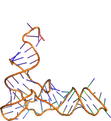 RNA structure prediction
RNA structure prediction
The view of RNA as simple information transfer molecule has been continuously challenged since the discovery of ribozymes. Moreover, the recent discovery of tiny RNA molecules such as µRNAs and small interfering RNA, are transforming our thinking about how gene expression is regulated.
Functional RNA molecules fold into their native three-dimensional conformations essential for performing their biological activity. Despite advances in understanding the folding and unfolding of RNA molecules, our knowledge of the atomic mechanism by which RNA molecules adopt their biological active structures is still limited. Moreover, we have limited knowledge on how non-coding RNA molecules regulate gene expression in health and disease.
Fortunately, there has been a recent burst of interest in RNA at all levels of resolution, including sequence, structure and function. Many new methods are appearing for characterizing how RNA sequences fold and perform their functions. However, to our knowledge, very few (if any) of such new methods are systematically exploiting the evolutionary record of RNA structures. Over the past years, we have established a line of research dedicated to RNA. We have been making use of structural data in the Protein Data Bank to develop new methods for aligning RNA structures, assigning function to new RNA structures, and determining the limits of automatic RNA comparative structure prediction.

